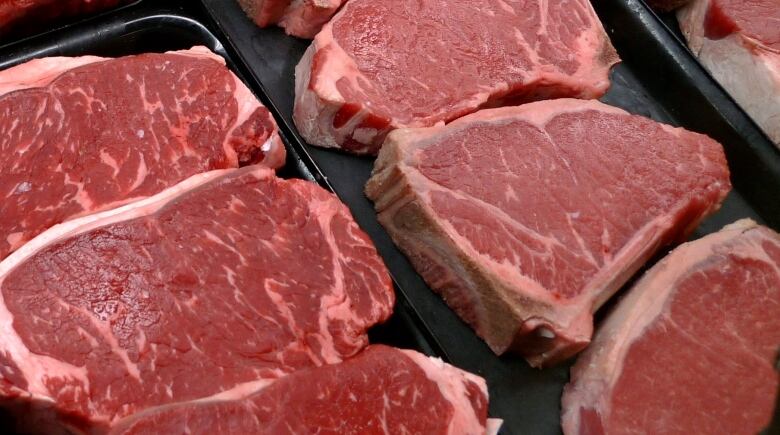How this summers drought could have you paying high beef prices again next year
The impact of this summer's drought across the Prairies could be felt by Canada's cattle sector for the next two to three years, according to market watchers, with consumers continuing to face high beef prices.
Hot, dry weather has strained pastures and hampered hay production at a time when farmers are usually producing feed for winter. Feed costs have spiked as a result.
The situation has ranchers weighing the difficult decision to sell their cattle early, with potentially large numbers expected to be sold to slaughter.
If the drought results in smaller herds, it could keep beef prices â€" already high due to strong demand â€" elevated, with fewer cattle coming to market over the next couple years.
"If you sell cattle due to a drought, it takes you two or three years or more to rebuild that supply chain and rebuild those supply numbers," said analyst Brian Perillat, of Canfax, a division of the Canadian Cattlemen's Association that tracks cattle market data.
"That sort of medium-term outlook is continued high beef prices, assuming this demand in North America and internationally remains strong. So you just don't see much relief down the line for consumers any time soon."
 If cattle herds shrink this summer, it could keep beef prices high for the next couple of years, as the supply chain recovers. (J. Scott Applewhite/The Associated Press)
If cattle herds shrink this summer, it could keep beef prices high for the next couple of years, as the supply chain recovers. (J. Scott Applewhite/The Associated Press) The summer's drought has been widespread, stretching from northwest Ontario to B.C.
"Pasture and forage conditions continue to deteriorate across Western Canada and a large area of the U.S.," said livestock market analyst Jason Wood, with Alberta Agriculture and Forestry, in a report Thursday.
Prices on the rise since JanuaryThe drought comes as North American consumers have seen beef prices rise with growing demand, as pandemic-related public health restrictions ease and restaurant dining opens up.
Statistics Canada's monthly average retail food price data shows the cost of several popular cuts of beef largely increasing from the start of the year through June.
The average price of a sirloin steak, according to the data, climbed from $22.68 per kilogram in January to $24.34/kg in June â€" an increase of more than seven per cent.
Economists have said rising demand isn't the only factor driving price increases at the grocery stores, also pointing to COVID-related supply chain issues and the Canadian dollar.
But even if more ranchers sell their cattle on the market in the coming weeks, analysts aren't expecting beef prices to tumble, due to strong domestic and international demand.
"If there is a silver lining to the increased liquidation of cattle due to the drought, it is that demand remains strong for beef," said Farm Credit Canada economist Leigh Anderson in an email.
 Dry, hot weather has hit pastures and hampered hay production at a time when farmers are usually producing feed for winter, resulting in a spike for feed costs. (Bonnie Allen/CBC)
Dry, hot weather has hit pastures and hampered hay production at a time when farmers are usually producing feed for winter, resulting in a spike for feed costs. (Bonnie Allen/CBC) "In addition, rising [COVID] cases in the U.S. has spurred consumers, wholesalers and restaurants to stock up on beef as concerns over potential restrictions surface again," he said.
"Strong demand is likely to support consumer prices, even with the marketing of additional cattle."
Anderson said one potential "wild card" for consumer prices of beef is the direction of the pandemic; a fourth wave could disrupt either supply or demand â€" or both â€" impacting prices in either direction.
Export demand highAccording to Canada Beef, which helps market the country's beef and cattle sector, beef exports are up 18 per cent this year, as of June.
"I don't see anything on the global horizon that's going to change demand," said Michael Young, the agency's chief executive. "Demand will remain high."
But domestic beef prices are unlikely to march much higher without a consumer response, cautions Sylvain Charlebois, senior director of the Agri-Food Analytics Lab at Dalhousie University in Halifax.
Higher beef prices could lead shoppers to seek other sources of protein, he said, noting that beef prices are up about eight per cent overall from the start of the year.
"The thing about meat-counter economics, though, is that there's not a whole lot of space anymore to move up, because you're likely to spook consumers," Charlebois said.
"They just could walk away from the category altogether and consider either the other two components of the meat trifecta: pork and chicken. Or they actually just could go on and buy a plant-based or another source of protein."
0 Response to "How this summers drought could have you paying high beef prices again next year"
Post a Comment